What Does the Immaculate Heart of Mary Symbol Represent?
The symbol of the Immaculate Heart of Mary encompasses deep theological significance, reflecting her pure love and maternal compassion. Historically emerging in the Middle Ages, it is depicted with elements like a pierced heart, radiating light, and encircling roses or flames, symbolizing her sinlessness, sorrow, and divine grace.
Influential figures like St. Bernard of Clairvaux and St.
John Eudes emphasized its importance. This symbol articulates Marian doctrines like the Immaculate Conception and Mary's role as an intercessor.
Devotional practices and artistic representations continue to enrich faith, offering profound insights into Mary's virtues and spiritual significance. Discover more ahead.
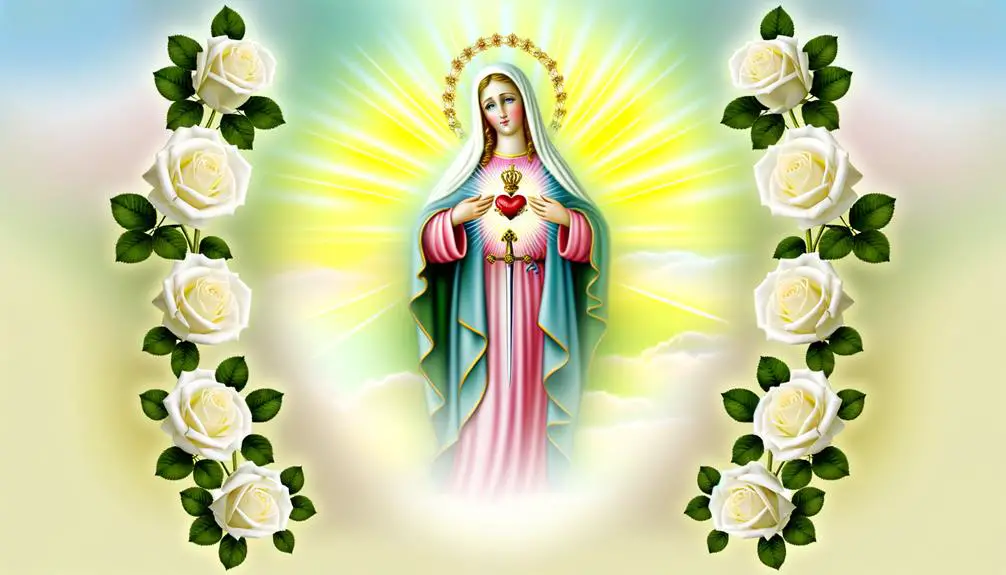
Key Takeaways
- The Immaculate Heart of Mary is often depicted with a pierced heart, symbolizing her sorrow and compassion.
- The heart is encircled by roses or flames, representing purity and maternal love.
- A crown of thorns around the heart signifies Mary's shared suffering with Christ.
- Light radiating from the heart symbolizes divine grace and sanctity.
- The sword piercing the heart highlights Mary's deep sorrow and maternal tenderness.
Historical Origins
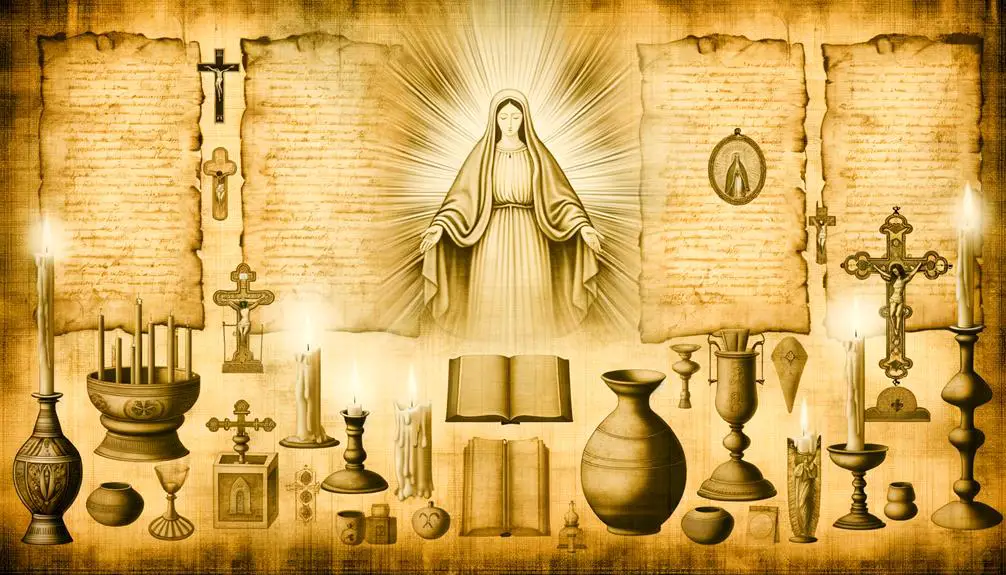
The concept of the Immaculate Heart of Mary finds its roots in early Christian devotion and theological reflection, emerging prominently in the devotional practices of the Middle Ages. Initially linked with the veneration of the Virgin Mary, the symbolism of her heart evolved as a focal point for contemplating her purity, maternal love, and sorrow.
Ecclesiastical writings from as early as the 12th century, such as those by St. Bernard of Clairvaux, began to emphasize Mary's compassionate and immaculate heart as a model for Christian life. By the 17th century, figures like St. John Eudes further developed and popularized these devotions, intertwining them with the Sacred Heart of Jesus, thereby solidifying the Immaculate Heart's place in Catholic spirituality.
Theological Significance
Building upon its historical roots, the theological significance of the Immaculate Heart of Mary lies in its profound representation of her sinless nature, profound love, and unwavering obedience to God's will.
This sacred symbol serves as a powerful theological construct, embodying key Marian doctrines and their implications for Christian spirituality. The Immaculate Heart illuminates several essential aspects:
- Sinlessness: Reflects Mary's immaculate conception and freedom from original sin.
- Maternal Love: Exemplifies her boundless love for humanity, mirroring Christ's own love.
- Obedience: Highlights her complete submission to divine will, serving as a model for all believers.
- Intercession: Emphasizes her role as intercessor, advocating for humanity before God.
Through these dimensions, the Immaculate Heart of Mary invites deeper engagement with the mysteries of faith.
Symbolism and Imagery
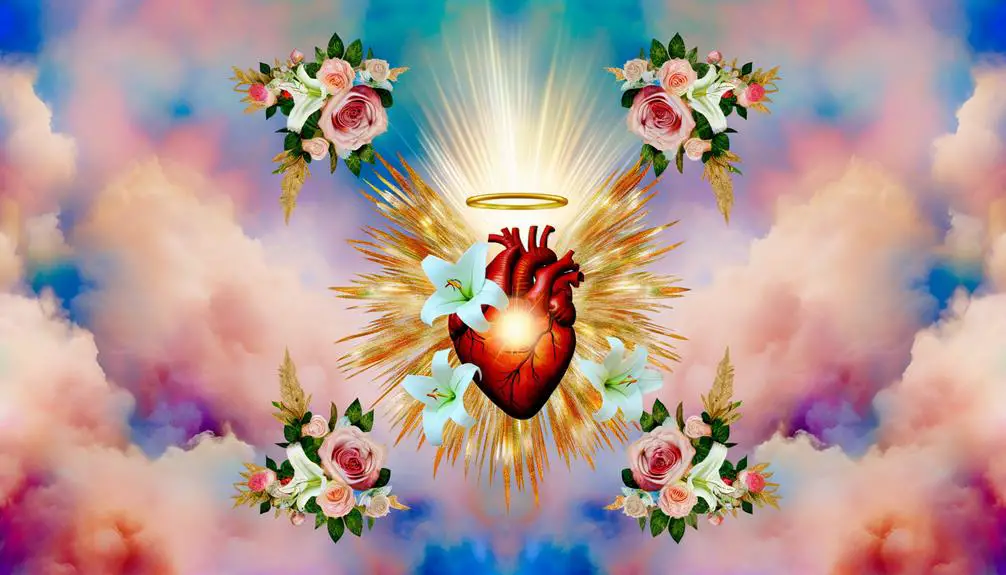
Symbolism and imagery associated with the Immaculate Heart of Mary convey profound theological and spiritual insights, enriching the devotional life of the faithful. Central to this symbolism is the depiction of Mary's heart, often shown pierced by a sword, which reflects Simeon's prophecy and signifies her deep sorrow and compassion.
Encircled by roses or flames, the heart symbolizes purity, love, and the burning zeal for God and humanity. The imagery of light radiating from the heart underscores Mary's role as a beacon of divine grace and intercession.
These elements collectively serve to deepen the understanding of Mary's virtues, inviting the faithful to emulate her unwavering faith, maternal tenderness, and boundless love in their own spiritual journeys.
Artistic Representations
Throughout history, artistic representations of the Immaculate Heart of Mary have played an important role in expressing and reinforcing theological concepts and devotional practices within the Christian tradition. These depictions often serve as visual catechesis, enhancing the faithful's understanding and veneration of Mary's profound love and sorrow.
Key elements frequently featured in these works include:
- Flaming Heart: Symbolizing ardent love and divine charity.
- Crown of Thorns: Representing Mary's shared suffering with Christ.
- Sword Piercing the Heart: Indicating Simeon's prophecy and Mary's sorrow.
- Rays of Light: Manifesting the purity and sanctity of her heart.
Through these symbols, artists convey deep spiritual truths and invite contemplation, fostering a richer, more intimate connection with the Immaculate Heart of Mary.
Devotional Practices
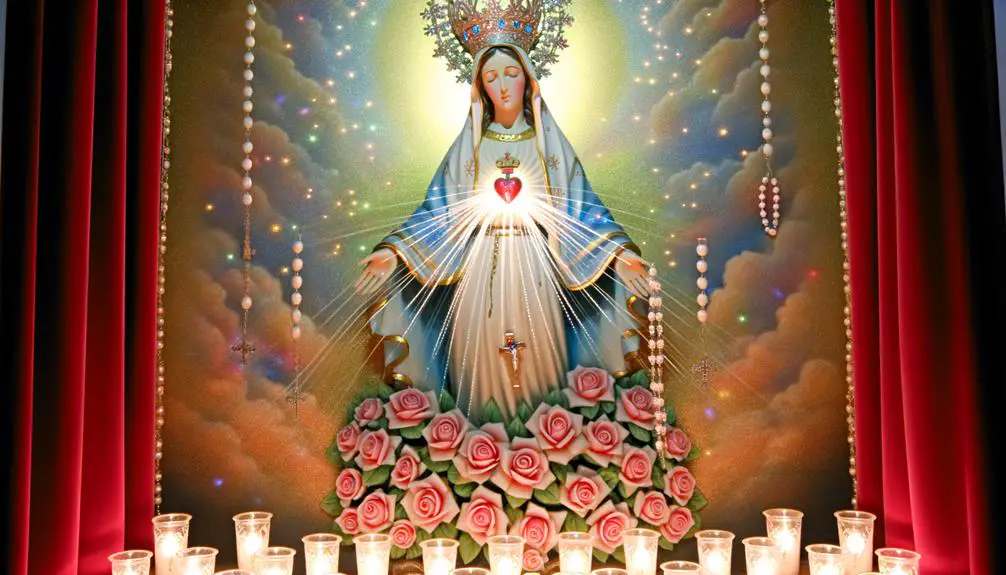
Devotional practices dedicated to the Immaculate Heart of Mary encompass a range of activities that foster spiritual growth and veneration.
Daily prayer rituals, the incorporation of Sacred Heart imagery, and the observance of specific feast day celebrations collectively play an essential role in cultivating a deep-seated reverence for Mary's heart.
These practices not only enhance personal piety but also unite the faithful in a shared expression of faith and devotion.
Daily Prayer Rituals
Daily prayer rituals dedicated to the Immaculate Heart of Mary serve as a profound expression of faith, inviting the faithful to engage in consistent spiritual reflection and deepen their devotion. These rituals often encompass structured and intentional practices that enable adherents to cultivate a closer relationship with Mary and, through her, with God.
Key elements of these daily routines include:
- Reciting the Rosary: A meditative prayer that reflects on the life of Christ through Mary's perspective.
- Morning and Evening Prayers: Specific prayers to start and end the day in contemplation.
- Marian Litanies: A series of petitions invoking Mary's intercession.
- Meditative Reading: Reflecting on Marian scriptures and theological works.
Such practices create a disciplined spiritual environment fostering continuous growth in faith.
Sacred Heart Imagery
The veneration of the Sacred Heart of Mary through devotional imagery serves as a visual and spiritual focal point, enhancing the faithful's understanding and appreciation of her compassionate and maternal love.
These images typically depict the Immaculate Heart surrounded by flames, symbolizing her burning love for humanity, and often pierced by a sword, reflecting her profound sorrows. The crown of roses encircling the heart signifies purity and devotion.
Through these symbols, believers are invited to meditate on Mary's virtues and her pivotal role in the salvation narrative. This practice fosters a deeper emotional and spiritual connection, encouraging the emulation of her virtues in daily life and reinforcing the theological significance of her Immaculate Heart within the broader context of Marian devotion.
Feast Day Celebrations
Feast Day celebrations dedicated to the Immaculate Heart of Mary encapsulate a rich tapestry of liturgical practices and communal rituals that underscore the profound reverence and theological significance attributed to her in Catholic tradition. These observances, typically held on the Saturday following the Feast of the Sacred Heart, serve to deepen the faithful's devotion and understanding.
- Liturgical Masses: Special Eucharistic celebrations focusing on Marian hymns and prayers.
- Rosary Recitations: Communal praying of the Rosary, emphasizing the mysteries of Mary's life.
- Processions: Public processions featuring statues or icons of the Immaculate Heart.
- Consecration Prayers: Formal acts of consecration to Mary's Immaculate Heart by individuals and communities.
These elements foster a spiritual environment conducive to contemplation and veneration.
Comparisons With Sacred Heart
The Immaculate Heart of Mary and the Sacred Heart of Jesus are both central to Catholic devotion and exhibit distinct visual symbols and theological emphases.
The Immaculate Heart is often depicted with a sword piercing it, symbolizing Mary's sorrows, emphasizing purity and maternal compassion.
On the other hand, the Sacred Heart is encircled by a crown of thorns, representing Christ's passion, and underscores divine love and sacrifice.
Visual Symbolic Differences
In examining the visual symbolic differences between the Immaculate Heart of Mary and the Sacred Heart of Jesus, one immediately notices the distinct presence of a sword piercing Mary's heart, symbolizing her sorrow and suffering. Additionally, the Immaculate Heart is often encircled by roses, representing purity and love, while the Sacred Heart is crowned with thorns, signifying Christ's Passion.
Flames: Both hearts are surrounded by flames, symbolizing divine love.
Cross: The Sacred Heart features a cross atop, denoting Jesus' sacrifice, absent in the Immaculate Heart.
Color Symbolism: The Immaculate Heart often uses softer tones, emphasizing maternal tenderness.
Expressions: Artistic depictions show Mary with serene, contemplative expressions, contrasting Jesus' often agonized portrayal.
These elements enrich the visual narrative of devotion.
Theological Emphasis Variations
While both the Immaculate Heart of Mary and the Sacred Heart of Jesus occupy central roles in Christian devotion, their theological emphases reveal distinct dimensions of divine love and redemption. The Immaculate Heart symbolizes Mary's purity, maternal love, and her role in intercession, whereas the Sacred Heart emphasizes Jesus' sacrificial love and redemptive suffering for humanity.
| Aspect | Sacred Heart of Jesus | Immaculate Heart of Mary |
|---|---|---|
| Representation | Jesus' divine love and sacrifice | Mary's purity and maternal compassion |
| Symbolic Elements | Crown of thorns, flames, cross | Sword piercing, roses |
| Theological Focus | Atonement, mercy, divine justice | Intercession, maternal care, purity |
| Devotional Practices | First Fridays, Eucharistic adoration | First Saturdays, Rosary |
These nuanced distinctions enrich the spiritual landscape, offering believers a detailed understanding of divine love and human sanctification.
Cultural Impact
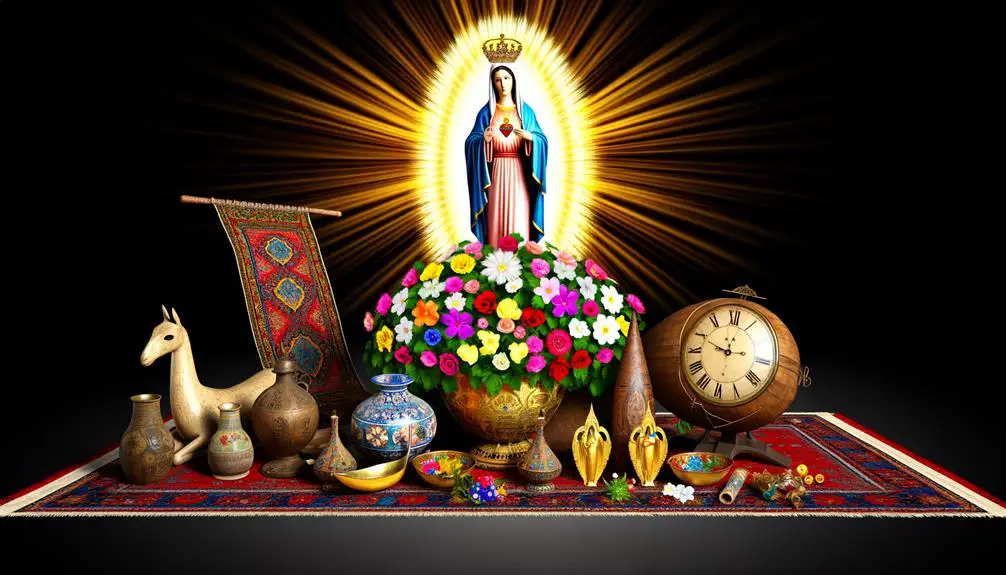
Through centuries of devotion, the Immaculate Heart of Mary has profoundly influenced various aspects of cultural and religious life, manifesting in art, music, and communal practices. This venerated symbol has served as an inspiration, nurturing faith and shaping traditions within Christian communities.
The cultural impact of the Immaculate Heart of Mary can be observed in several key areas:
- Artistic depictions: Renowned artists have immortalized the Immaculate Heart in paintings and sculptures, enriching religious art.
- Liturgical music: Hymns and compositions have been dedicated to the Immaculate Heart, enhancing worship experiences.
- Feast days: Special days are dedicated to celebrating the Immaculate Heart, fostering communal gathering and prayer.
- Devotional practices: Rosaries and novenas focusing on the Immaculate Heart promote personal and collective piety.
These manifestations underscore the symbol's enduring cultural resonance.
Modern Interpretations
Amid contemporary theological discourse, modern interpretations of the Immaculate Heart of Mary reveal a dynamic interplay between tradition and evolving spiritual insights. Scholars and theologians explore how the symbol reflects current social and spiritual contexts, emphasizing themes of compassion, resilience, and maternal love. This evolving understanding enriches the faith experience, offering believers a profound connection to Mary's virtues.
| Aspect | Traditional View | Modern Interpretation |
|---|---|---|
| Compassion | Intercession for humanity | Active empathy and social justice |
| Resilience | Spiritual steadfastness | Emotional and psychological strength |
| Maternal Love | Unconditional nurturing | Inclusive and universal care |
| Devotional Practice | Rituals and prayers | Personal and communal spirituality |
| Theological Impact | Doctrinal significance | Contextual and experiential faith |
These interpretations serve as a bridge, integrating timeless devotion with contemporary relevance.
Conclusion
The Immaculate Heart of Mary, steeped in rich historical and theological layers, serves as a profound symbol of divine love, purity, and maternal intercession. Its intricate imagery and artistic representations invite deeper contemplation, while devotional practices and cultural manifestations underscore its enduring relevance.
Through symbolic parallels with the Sacred Heart and evolving modern interpretations, the Immaculate Heart continues to inspire faith and devotion, embodying a celestial beacon guiding the faithful toward spiritual renewal and divine grace.






